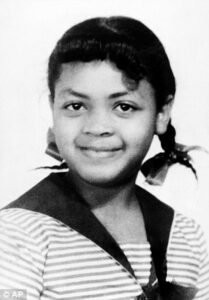…as a little girl was at the center of the 1954 Brown v. Board of Education Supreme Court decision.
 The Topeka girl was just nine years old when her father Oliver Brown tried to enroll her at Sumner Elementary School, an all white school in 1951.
The Topeka girl was just nine years old when her father Oliver Brown tried to enroll her at Sumner Elementary School, an all white school in 1951.
When the school refused to allow the black pupil to enroll, her father sued the Topeka Board of Education.
The lawsuit led to the famous 1954 Supreme Court case of Brown v. Board of Education. Linda’s father was lead plaintiff in the case that saw the Supreme Court end school segregation.
Linda Brown died at age 76 Sunday afternoon at the Peaceful Rest Funeral Chapel in Topeka.
Her sister, Cheryl Brown Henderson, founding president of The Brown Foundation, confirmed the death to The Topeka Capital-Journal.
Her legacy is not only renown in Kansas, but nationwide, according to Kansas Deputy Education Commissioner Dale Dennis.
He says the effect she had ‘on our society would be unbelievable and insurmountable.’
‘This is a huge loss to our community,’ Topeka mayor Michelle De La Isla said.
‘We will continue to champion civil rights. When you look at the diversity of our community, I think we’re already honoring her legacy,’ she added.

To celebrate the 50th anniversary of the famous Supreme Court decision she inspired she spoke at Purdue University in 2004 to share her experience growing up in segregated Topeka
‘Sixty-four years ago a young girl from Topeka brought a case that ended segregation in public schools in America. Linda Brown’s life reminds us that sometimes the most unlikely people can have an incredible impact and that by serving our community we can truly change the world,’ Kansas governor Jeff Colyer said in a statement on Twitter.
In 1951 after Linda was denied enrollment at Sumner Elementary, she attended Monroe Elementary School where she sat in an all-black classroom.
Just three years later her father’s efforts – working with the parents of five other black children who also rallied to integrate schools – would change the face of public schools forever.
Oliver Brown joined a dozen other plaintiffs to form a NAACP legal challenge of segregation in Kansas schools, according to CNN.
The lawsuit saw the US Supreme Court rule unanimously that ‘separate but equal’ schools violated the equal protection clause of the Constitution’s 14th Amendment in May 1954.
In 1985 Linda reflected on her father’s lawsuit for the documentary series Eyes on the Prize: America’s Civil Rights Years.
‘My father was like a lot of other black parents here in Topeka at that time. They were concerned not about the quality of education that their children were receiving, they were concerned about the amount — or distance, that the child had to go to receive an education,’ she said.
‘He felt that it was wrong for black people to have to accept second-class citizenship, and that meant being segregated in their schools, when in fact, there were schools right in their neighborhoods that they could attend, and they had to go clear across town to attend an all-black school,’ she added.
‘And this is one of the reasons that he became involved in this suit, because he felt that it was wrong for his child to have to go so far a distance to receive a quality education,’ she said.
On May 4, 1987 both of the elementary schools she attended – Monroe and Sumner – became National Historic Landmarks.
Written for the Associated Press and Marlene Lenthang and published by The Daily Mail ~ March 26, 2018.
